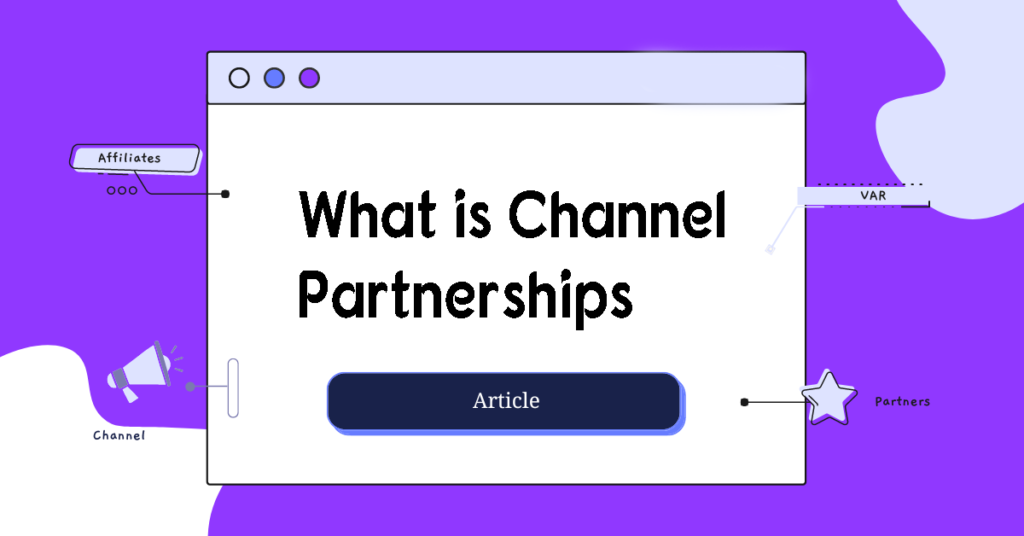When it comes to growing a business, what is channel partnerships? It’s a powerful strategy that can dramatically boost your company’s reach and revenue. But like any complex strategy, it requires understanding and careful implementation.
Digging through countless articles, forums, or LinkedIn posts might leave you feeling overwhelmed by the complexity of channel partnerships. You may even stumble upon voices saying that without prior experience in managing such relationships, businesses are bound to fail.
This simply isn’t true. There are numerous companies out there leveraging their channel partners effectively with little initial know-how about how these strategic alliances work.
The beauty of the channel partnerships landscape lies in its diversity and adaptability. New types of partners emerge constantly as technology evolves – from Managed Service Providers
Unlocking the Potential of Channel Partnerships
In today’s competitive business landscape, channel partnerships hold the key to transformative growth and success. These strategic alliances not only streamline operations but also reduce costs, offering businesses an undeniable competitive advantage.
The Power of the 80/20 Rule in Channel Strategy
A core principle that underscores the importance of these relationships is the renowned 80/20 rule. This concept suggests that roughly 20% of a vendor’s partners are responsible for generating about 80% of their indirect sales channel’s revenue.
This implies that identifying and nurturing high-performing partners within your network can significantly maximize the return on investment from partner relations. Yet it doesn’t mean overlooking other affiliates; they still contribute to revenue generation and often serve as essential testing grounds for new strategies or products before broader implementation.
Cultivating High-Value Relationships with Top Performing Partners
To foster successful associations with top-performing channel partners, maintaining consistent communication forms an integral part. Regular engagement through meetings or updates regarding product changes or company news helps build strong bonds with these entities.
Beyond regular interaction, recognizing performance appropriately plays another crucial role. Incentive programs like bonuses or exclusive access to certain resources can motivate such high-value associates towards achieving even greater results.
Navigating challenges such as overlapping territories requires effective solutions too – one being clear delineation boundaries agreed upon by both parties involved in partnership agreements.
Maintaining Balance Within Your Partner Ecosystem
Prioritizing top performers based on this rule has proven beneficial for many organizations’ growth strategy, yet ensuring balance within your partner ecosystem remains equally important.
Businesses must ensure not becoming overly reliant on just a few contributors but spreading risk adequately among several reliable associates who collectively drive success reaching different market segments effectively.
This diversified approach builds resilience against unexpected disruptions while securing steady growth over time, which ultimately enhances overall sales support, thereby increasing competitiveness in the software company industry.
Key Takeaway:
Channel partnerships are a golden ticket to business growth, with the 80/20 rule highlighting that a select few partners often drive most revenue. Regular communication and incentives can boost these high-value relationships. However, it’s vital not to put all your eggs in one basket – diversifying risk among several reliable associates ensures resilience and steady growth.
Exploring Business Growth: What is Channel Partnerships?
Channel partnerships are a vital component in the complex landscape of business collaborations. They serve as a beacon for growth and market expansion, offering unique benefits to businesses. Let’s delve into the different types of channel partnerships and how they can boost business growth.
Decoding Types of Channel Partners
Channel partnerships come in various forms, each with its own advantages for businesses. Let’s explore three common types:
Original Equipment Manufacturer (OEM)
An Original Equipment Manufacturer (OEM) is an independent company that manufactures components. These components are then purchased by another entity and sold under their brand name. This type of partnership allows companies to leverage the manufacturing expertise of their partners while focusing on core areas such as marketing and sales support.
Systems Integrator (SI)
A Systems Integrator (SI) plays a crucial role in enhancing operational efficiency within organizations. They bring together hardware and software from different vendors, integrating them into comprehensive solutions. By merging these systems into one cohesive unit, SIs help businesses streamline their operations and increase productivity.
Distributor
Distributors act as intermediaries between producers or service providers and end-users. They purchase products wholesale from the original producers and then sell them to retailers or direct consumers. This type of partnership allows businesses to expand their market reach without requiring significant investments in distribution networks.
By understanding the different types of channel partnerships and their benefits, businesses can strategically choose the right partners to accelerate their growth and achieve success in the market.
Unleash your business potential with channel partnerships. From OEMs to Systems Integrators and Distributors, explore how these collaborations can drive growth and market expansion. #BusinessGrowth #ChannelPartnershipsClick to Tweet
Maximizing Competitive Advantage Through Channel Partnerships
In the fiercely competitive business landscape, channel partnerships have emerged as a potent tool for gaining an edge. These strategic alliances allow businesses to penetrate new markets and augment their offerings.
A successful channel partnership is one where both parties reap benefits, often leading to enhanced market share and improved profitability.
The Success Story of Software Giants Leveraging Channel Partnerships
An excellent example of this strategy in action can be seen within software industry giants who leverage their partner networks extensively. This approach allows them to focus on core competencies while drawing upon the specialized services offered by partners – resulting in comprehensive solutions that drive growth.
This model has proven particularly effective for major players such as Microsoft whose extensive network of solution providers plays a crucial role in driving sales revenue through indirect channels.
Differentiation: The Key To Winning With Channel Partnerships
In today’s saturated marketplace, differentiation holds the key to standing out from competitors. A well-orchestrated channel partner program not only broadens customer reach but also delivers unique value propositions which distinguish companies from rivals. Salesforce’s AppExchange Partner Program, for instance, offers unmatched choice and flexibility by enabling thousands of independent company vendors globally develop applications atop its platform – creating an expansive ecosystem around Salesforce’s CRM product offering unparalleled choices across various industries.
Channel partnerships are a game-changer in today’s competitive business landscape. They offer businesses an edge, enabling penetration into new markets and boosting profitability. #BusinessGrowth #PartnershipsClick to Tweet
Role and Benefits of Channel Partners
The business landscape is a complex web, with channel partners serving as crucial nodes. They act as an extension of your in-house sales team or service division, aiding in the distribution and sale of products or services.
Channel partnerships also offer technical support—a lifeline for software companies. With their expertise at hand, businesses can ensure customers get timely help when they need it most while freeing up internal resources to focus on what they do best.
The Impact on In-House Sales Teams
A common myth about channel partnerships suggests that these alliances compete against in-house sales teams. However, this isn’t always true—quite the opposite.
In fact, successful channel partner programs supplement the efforts of an existing sales force by offering additional resources and know-how. This collaboration between external partners and internal teams enhances overall performance, leading to increased revenues—an outcome any investor would appreciate.
Gaining Market Reach Through Channel Partnerships
An essential benefit derived from engaging with solution providers lies within expanding market reach—the secret sauce behind many success stories. Independent company affiliates often have established relationships with local clientele; hence, such affiliations allow your product or service access to areas otherwise challenging to penetrate directly.
Beyond geographical boundaries expansion, these strategic alliances diversify customer demographics too, as each affiliate partner brings unique connections based on industry sector or target audience segment. This widened exposure leads to better brand recognition alongside greater revenue generation opportunities.
Growth Opportunities Via Reduced Costs And Increased Support
Last but not least are cost savings associated with using indirect channels for distribution rather than investing heavily in building direct routes yourself—a strategy particularly beneficial for startups looking to conserve capital while scaling operations swiftly.
Furthermore, the additional support provided by experienced managed service providers helps streamline processes, leading to higher efficiency levels, besides ensuring long-term growth prospects through strategic collaborations. A win-win situation indeed.
Key Takeaway:
Channel partnerships are vital cogs in the business machinery, supplementing sales efforts and expanding market reach. They’re not just about competition but collaboration, offering technical support and increasing revenues. Moreover, they help penetrate tough markets, diversify customer base, reduce costs and boost efficiency—a real win-win.
Crafting a Winning Channel Partner Strategy
Formulating an effective channel partner strategy goes beyond merely selecting the right partners. It’s about aligning your business goals and objectives with theirs, leading to increased sales support, market reach, and fostering a mutually beneficial relationship.
Identifying Goals and Objectives: The Starting Point
The first step in crafting this winning strategy is pinpointing clear-cut business goals. Whether it’s broadening your horizons into new markets or enhancing product offerings through additional resources from partners – having well-defined targets helps steer strategic decisions.
You also need to ponder over what you expect from these partnerships. Are they going to provide technical support? Or perhaps help extend your market reach? Understanding these expectations upfront will ensure that both parties are on the same page when entering into partnership agreements.
Prioritizing clear goals for your partnership program paves the way for evaluating potential partners who can help achieve them. Remember – it’s crucial to choose companies that complement rather than compete with yours in terms of products or services offered.
A thorough evaluation process might include checking their reputation within the industry or reviewing customer feedback online. The goal here isn’t just finding reliable solution providers but those who share similar values as well.
Developing a Partnership Plan: A Comprehensive Approach
Moving forward involves developing a comprehensive plan detailing how each party contributes towards achieving mutual objectives. This includes defining roles such as whether one company acts as an independent software vendor while another takes up responsibilities like managed service provider duties.
One common challenge faced during managing channel partnership is dealing with overlapping territories among other key areas of collaboration. A successful plan should cover aspects like training programs for sales teams on new products/services introduced by the partner company along with mechanisms for conflict resolution between overlapping territories.
Key Takeaway:
A successful channel partner strategy hinges on clear business goals, mutual alignment, and a comprehensive plan. It’s not just about finding reliable partners but those who share similar values and can complement your offerings. Overcoming challenges like overlapping territories is key to effective collaboration.
Exploring Business Growth: What is Channel Partnerships?
Explore what channel partnerships are, their types, and how they boost business growth. Uncover strategies for success in our comprehensive guide.
Exploring Successful Channel Partner Programs
A successful channel partner program is a powerful tool that can significantly boost your business’s growth and market reach. To illustrate, let’s examine the strategies employed by top software companies in their own programs.
The anatomy of an effective partnership program
In developing a robust channel strategy, clear communication between you and your partners plays a crucial role. This involves setting realistic expectations about roles within the partnership from day one, as well as maintaining open lines of communication throughout to enhance collaboration efforts.
Beyond these foundational aspects lies another critical component: creating mutually beneficial relationships with your channel partners. The goal here isn’t merely increasing sales; it’s also about fostering long-term partnerships based on trust and shared objectives.
Fostering Mutually Beneficial Relationships
An effective way to achieve this mutual benefit is through regular incentives or rewards for affiliates within your partner program. These could include discounts on products or services provided by you or additional support during peak periods – all aimed at motivating partners towards achieving common goals together.
Prioritizing Continuous Learning
Lastly but importantly, successful channel partner programs prioritize continuous learning opportunities for participants. This includes access to ongoing training sessions designed specifically toward enhancing product knowledge along with improving selling techniques.
This approach helps keep affiliate partners updated with the latest trends while honing their abilities further. It creates an environment where both parties are continually growing – thereby making the relationship truly symbiotic, which eventually leads to increased indirect sale channels’ revenue.
Unlock business growth with channel partnerships. They’re not just about boosting sales, but also building long-term relationships based on trust. Dive into our guide to learn more. #BusinessGrowth #ChannelPartnershipsClick to Tweet
Navigating Challenges in Channel Partnerships
Channel partnerships, while powerful tools for businesses, come with their own unique set of challenges. These can range from maintaining consistent communication across different partners and territories to managing overlapping market spaces.
The key lies in effective management strategies.
An old adage says that “communication is the lifeblood of any organization.” This holds particularly true when it comes to channel partnerships.
To ensure smooth functioning despite geographical differences or varying business practices among partners, establishing clear lines of communication becomes paramount. Defining expectations about the frequency and nature of updates, along with designating responsibility for initiating these conversations, are essential steps towards this end.
Role of Channel Partner Managers
In the world where multiple entities vie for a share in the same territory – another common challenge within channel partnership – the role played by competent channel partner managers cannot be overstated. They act as navigators, steering through potentially conflicting interests, ensuring each partner has its unique space within the market while minimizing potential conflicts.
A successful channel partner manager must possess more than just effective bargaining abilities; they should also have a deep knowledge of both their company’s offerings and those provided by the partners. Knowledge sharing platforms like Slack Enterprise Grid, which facilitate seamless collaboration between teams regardless of geographical location, become indispensable here.
Beyond handling territorial issues, channel partner managers play a pivotal role in resolving disputes that arise during the course of partnership operations, acting as mediators between the parties involved. They work tirelessly to maintain a mutually beneficial relationship with all stakeholders involved, irrespective of the differences that might crop up due to differing cultures and practices amongst them. It’s imperative that companies not only choose the right people as their channel managers but also equip them with the proper resources necessary to manage the complex dynamics inherent in such relationships effectively, thus contributing to the overall success of the venture.
Key Takeaway:
Channel partnerships can be a maze of challenges, from communication hurdles to territorial disputes. The key? Effective management strategies and competent channel partner managers who act as navigators, mediators, and knowledge sharers. Equip them well for a successful venture.
Conclusion
Channel partnerships are your secret weapon for business growth. They’re the alliances that bring new opportunities, reduce costs, and give you a competitive edge.
Different types of partners offer unique benefits. From OEMs to MSPs, each one can help expand your reach or provide specialized support.
They’re not just about distribution; they’re also about differentiation. A strategic partner can give you an edge over other competitors.
The role of channel partners goes beyond sales too. They open doors to new markets and amplify your in-house team’s efforts.
A winning strategy is key here though – goals, evaluation criteria, planning… it all matters when creating successful partnerships.
Affiliate partners? Yes! Include them in your broader channel strategy for even more potential gains!
Navigating challenges? It’s part of the game but with effective management by dedicated managers these hurdles become stepping stones towards success!
If you want to learn more about this, sign up for my newsletter.


